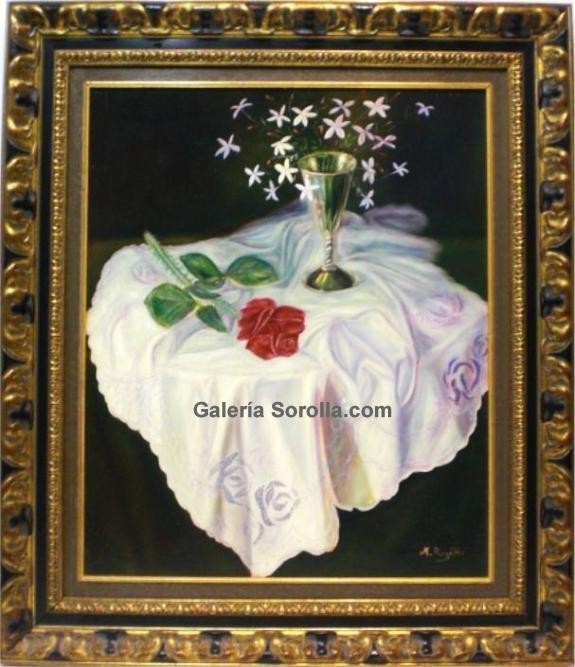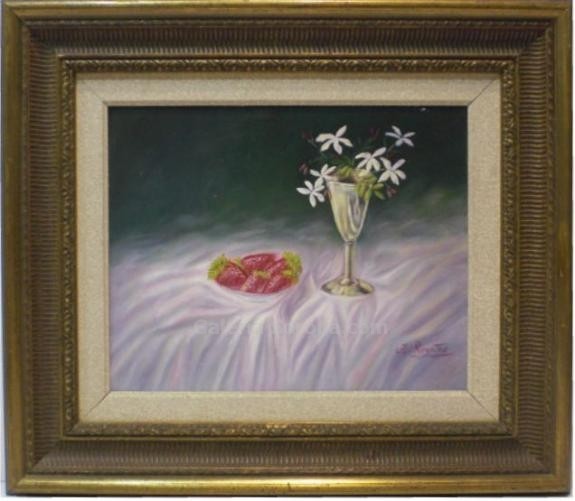Categories
RODOLFO REGAÑO



Rodolfo Regaño is an honest, gentle, consistent and simple painter. We agree on tastes and preferences. He says what he thinks whenever he thinks it is appropriate.
I was sympathetic but at first he seemed a bit reserved and somewhat reticent. For him, caution is not only foresight, precaution or a defensive posture, but a sense of confidence perhaps towards himself.
This way of being, this backdrop of his own character, fades away when he believes people to be sincere. Then he opens to conversation without hesitation, although he does not consider himself to be a man of words."Talking -he admits- is not for me."His words are his, as it is his art.
It was the morning of a gray November day. A warm, peaceful, morning that links us spiritually and facilitates the conversation. It is the peace of the home that surrounds us right now as if it were a special autumn fog.
I stare at his paintings as a film whose images succeed quickly. In the first meetings with the painters I've met before I've always preferred to look at their paintings in this way: as a film, almost quickly, without pausing. This way I can better see the spirit of the painter, the style that inhabits in them.
Regaño´s paintings give me a good impression. They have "soul". They throb. I do not think anyone can escape this impression they make on us. They are realistic paintings.
I would not dare to classify them under a declared "hyper" - realism. I gather his realism carries something in itself. Additionally Rodolfo writes on the canvases with his particular handwriting.
He said, or rather, he stated that the hyper-realistic painter can not be denied the recognition of his hard work. However, for Rodolfo it does not make any sense to do "what is already done". I understand he was referring to "what is done" in any photograph.
He thinks this way. According to that we can sense that in his paintings, in addition to specific drawing, the scrupulous profile, the real, all his ideals and his pictorial mastery pulsate underneath, besides his love for what he does, for what he's doing. His whole soul is in his work. It is not about achieving a perfect imitation, but to see the issue from one´s own viewpoint."Everything is in the eye of the beholder ..."And his standpoint is full with passion, feeling, excitement, rush ... In short, it is full of art, if that word can express what cannot be explained.
That autumn morning I met the painter and his work. Rodolfo has a strong face, stern and somewhat introverted. Robust, somewhat sleepy. He was dressed in a dapper and disheveled manner, although it may seem a contradiction. What I want to say is that he despises petulant fashions and clothing. He does not disguises himself with outdated bohemian or "hippie" outfits. Regaño is primarily a normal, intelligent person who has never known or wanted to make his particular "show" nor amuse anyone with circus acrobatics.
I said: "Everyone expresses themselves as they are..."A man of this disposition, born in Fuenteovejuna, already tended in his childhood towards drawing : in the schoolyard he painted instead of playing.
It is in Sevilla where- when he was only fourteen, he took classes from Juan Campos Campos, an accredited Sevillian painter who taught him his first lessons in drawing. When the young disciple asked permission to paint, the teacher repeated it again and again:
- It's too soon, Rodolfo ... First draw, then draw, and always draw! And the student obeyed him with the hope that one day he could take the brushes and color to his liking those already perfect drawings.
Undoubtedly the young and budding painter was influenced by the lessons of Campos, the Sevillian atmosphere and the tables he observed at the Andalusian museums, especially in Seville.
It is surprising that the works of the classic Sevillian painters tend toward the dark tones in their canvases devoid of light.
I, ignorant of the stylistic theories, do not understand why splendid, fascinating and joyous Seville light does seldom appear in the paintings of their classical painters.
Rodolfo does not understand what the secret of that dark art is. But when, a few years later, he moved to Sitges, he contacts with a Mediterranean-style painting. Later he discovers, in Barcelona, that it is possible to shed in the canvas the light of those villages, such as Sitges, bordering the sea, opening towards them with a generous joy.
In Sitges our painter was seduced by its narrow streets, white houses and its Mediterranean sun. His eyes are bathed in this light that dazzles and caresses. Then he tries lightning up his first canvases with bright colors . He nearly succeeds.
Rodolfo settles there and Sitges becomes the anvil which forges his personality as an artist and painter. He finds the city hospitable and full of overflowing sympathy. He remained five years in Sitges, a time during which he exhibited his first oil paintings at the galleries "La Nau",“Marrón”, “Santiago Rusiñol”, “Escala d´Art” y “Nueva”.
Our painter was then looking for new horizons but frequently returned to Sitges. He took this seaside city in his heart. He comes back again and again, and never will forget it because he remembers it as the place where he took his first steps, those which, through difficult, most loved and still loves.
At this point we begin to learn about the works of this, his first period. A stage full of hesitations similar to those of his friends - young artists, but also full of achievements. As an example, we can see in the first pages of this book, 'Composition with fruits', a painting that reveals some of the Seville school influences; nude drawing in which the drawing wears brighter colors, besides his early still lifes.
If Rodolfo liked the joy of Sitges ´ homes and streets, he would feel captivated by Barcelona, the open city he frequently visits .
Rodolfo explained to me that he will never forget the impact that the Catalan capital caused on him, both because of its monuments and for the welcome his future friends and acquaintances gave him.
In Barcelona he attended lessons at the "Cercle Artistic de Sant Lluc," and there he was able to become familiar with the teachers who were around. Barcelona was something else: so much so that after a short time he decided to settle there, abruptly suspending his relations with Sevilla, the land of his already distant adolescence.
Regaño settled in Barcelona, with the experiences of all that his loved Sitges had offered to him, and he began to paint with renewed vigor and new endeavors. Rodolfo then fumbles the possibilities of its powers and he thrills us with the spontaneity and realism of a Barcelona typical bustling street. Here are born his most representative artwork: Catalunya, Sants station, La Sagrada Familia, Park Guell ... These paintings are a true testimony of his passion for Barcelona. They highlights the interest and affection that our painter feels for Barcelona, a city which gives him shelter and offers him the chance to enter the pictorial world.
The paintings from this time period which have surprised me harder, are the two depicted in these pages, entitled Alfarero y Retrato de Eusebio. In them, the artist follows and departs from realism to give way to his feelings and emotions. His spirit is within these two paintings and his work.
Perfect drawing, sober fleeting landscape, intense light in both paintings and overwhelming humanity portrait that of Eusebius, of whom we would like to hear the events of his life. Next to the water jar, Eusebio rests and meditates ...
In this way the painter is consolidated. It's time to get noticed, to take flight, to present their work to the public, who applauds him at all times. He spreads and exhibits his works in many art galleries throughout the Spanish territory.
Critics discover his deep sixth pictorial sense, the result of long years of learning. This is expressed in their respective reviews. It has come for him, the moment to decide. He knows his own limitations. He will paint what he pleases."I have to enjoy myself, when I paint," he admits.Although he feels admiration for the beauty of the Catalan towns and rough or bucolic landscapes, bright or dark, Rodolfo declares honestly that the landscape as a pictorial subject, "is too big for me." Figure entails material requirements difficult to circumvent . He has yet the still lifes, which are intimate and cozy. They will make him famous. He'll love the lace embroidered by our grandmothers in the silence of their bedrooms and the shawls plagued with long bangs.
With them he will try to surpass himself and look for new themes. He likes a slow evolution, contrary to the revolution. He will try, therefore, to evolve, slowly but steadily. At this very moment his art evolves into a precious depiction of tiles. I would like to point out, in one of his paintings, the range from red and green hues that become the underlying base for two blue porcelain jars. The perfect combination of colors, his love for detail, always present in the whole painting, does not go unnoticed. I am sure anyone who has a minimum artistic sensibility will notice it.
This, I think, may be the way forward for this painter who lives in Barcelona; the way of evolution towards the subject that excites and interests him better than any other. Only when we are sincere with ourselves we can truly become artists.
Nevertheless, even despite his most intimate personal convictions, Rodolfo Regaño struggles in a world of doubt, hesitation, scruples and misgivings.
We can see his style is not 'fashionable'. He realizes that the more rigorous critics prefer broad and insinuating brushstrokes, maybe due to an ambiguity that necessarily leads to abstraction, difficult to capture by certain groups, who are perhaps a shrill and vociferous minority. He, however, is a painter who clings to detail, to the research of new techniques,to a realism as effective as it can be, to which Regaño also instills passion and feeling, the emotion he finds within himself.
In the field of art, it is very difficult to pinpoint borders, to place markers between good and evil. The very same critics, in general, if they are responsible, do not dare to define concepts or describe openly and without hesitation where the beauty lies. An artist can fit well in the current pure abstractionism - while, at the same time, in Velázquez's Las Meninas, or in the impressionism of Cezanne or Renoir. Who knows!
I believe in the sincerity of Rodolfo Regaño.
Because of what he told me, I respect him. With his modest and unpretentious demeanor, with his vigorous desires; throughout his work I - and so many others- appreciate him. And I do not try to judge him because I also know my limitations.
Now he continues with his tiles. What matters is that he does what he really likes to do. And the more it pleases the public, as it seems to be, the better.
We are nearing the end of our discussion ... and we wonder: What will the future be for our artist?How far will he go?
I am convinced that Rodolfo is not interested at all in answering these questions. We walk amidst, as the characters of the novel by Don Miguel de Unamuno, a dense fog of contradictions.
We look for the sun- as the song says- in a road full of shadows. This way we cannot get anywhere.
Regaño also seeks the light, but in other ways, to pour it into his canvases.Has he succeeded yet?
The true artist always longs to surpass himself. Regaño would answer no. That he has not succeeded.
Alejandro Cuéllar.

